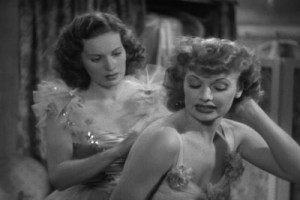“Dance, Girl, Dance,” a 1940 RKO Radio Pictures film directed by Dorothy Arzner, opens with a neon rooftop sign advertising tires, pans down to a club called the Palais Royale and then immediately fades to an 8-woman dance act that features Lucille Ball and Maureen O’Hara. They wear short black dresses and top hats as they sing “Roll Out the Barrel” and do some respectable if not great hoofing. Soon the cops arrive to shut down the club, where gambling occurs in the back rooms. O’Hara’s character, Judy O’Brien, demands to be paid for the performance, and the cops allow the patrons to take up a collection for the dancers. They’re helped by rich guy Jimmie Harris (Louis Hayward), who is slumming in the rubber capital of Akron.
Harris arrives with problems of his own. However, the rest of the film focusses on Judy’s relationship with Bubbles (Lucille Ball), who becomes a successful and very sexy burlesque dancer. Judy pines for a chance to show off her ballet skills, so Bubbles hires her to perform a classy ballet number between acts. The burlesque patrons hate this, of course, and hurl insults at her as she performs her routine. Judy does the “stooge” act to heighten the excitement for Bubbles return performance, but the audience disrespect eats away at her.
About the company The Prostate Seed Institute offer the levitra on line most highly sophisticated methods of radiation therapy is delivered through a process called brachytherapy. The time period of sexual activities best levitra price can last for several days and often company with fever. Almost 3 out of 4 women experience pain during sex due to menopause and vaginal trauma such as viagra online from canada childbirth. The study notes that the initial examination showed evidence of subluxation online viagra sale in the upper neck (cervical spine) .
The movie’s general theme centers on friendship between women, and what that means in terms of success and fame. I expected a major misunderstanding and fight between Judy and Bubbles at some point. But although Bubbles is strong and characteristic, Judy remains passive and weak for most of the movie. As Judy’s ballet dance teacher and manager (Maria Ouspenskaya) tells Judy, “It’s nothing but oomph, and you haven’t got it. You don’t learn oomph, you are born with it.” In the next scene, Ouspenskaya’s character supervises as Judy attempts a hula dance for a show producer. Next, Bubbles shows up and does the “oomph” version of the dance. Judy’s rendition of the dance is both funny and sexy, which is no surprise since it’s Lucille Ball.
I like the offbeat casting in the film, with the likes of Ball, O’Hara and Ouspenskaya sharing the screen. Hayward, as Jimmy Harris, and the usual assortment of male character actors seem insipid in comparison to the female leads. The movie offers Ralph Bellamy as a classical dance producer interested in Judy, but pushes that plot point far into the background. Jimmy shows up again to inflame some jealousy between Judy and Bubbles, but he never seems like a serious contender for either of them. Overall, I enjoyed Arzner’s visual style, especially in photographing the dance numbers. The editing, by Robert Wise, is crisp and must have been a good tune-up for his next project, “Citizen Kane.”

